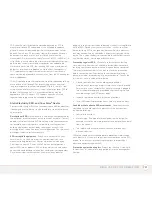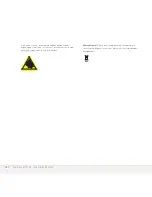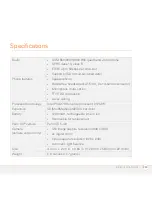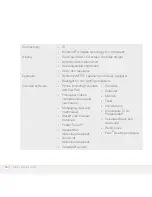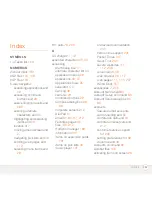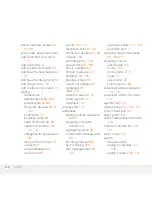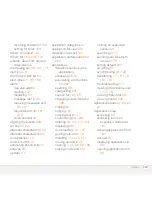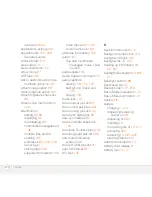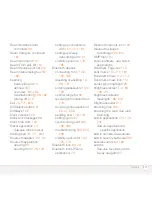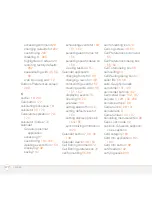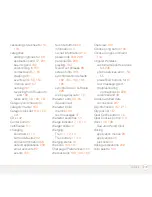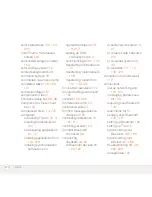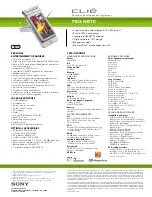
R E G U L A T O R Y I N F O R M A T I O N
259
Again, the scientific data do not demonstrate that wireless phones
are harmful. But if you are concerned about the RF exposure from
these products, you can use measures like those described above to
reduce your RF exposure from wireless phone use.
What about children using wireless phones?
The scientific
evidence does not show a danger to users of wireless phones,
including children and teenagers. If you want to take steps to lower
exposure to radiofrequency energy (RF), the measures described
above would apply to children and teenagers using wireless phones.
Reducing the time of wireless phone use and increasing the distance
between the user and the RF source will reduce RF exposure.
Some groups sponsored by other national governments have advised
that children be discouraged from using wireless phones at all. For
example, the government in the United Kingdom distributed leaflets
containing such a recommendation in December 2000. They noted
that no evidence exists that using a wireless phone causes brain
tumors or other ill effects. Their recommendation to limit wireless
phone use by children was strictly precautionary; it was not based on
scientific evidence that any health hazard exists.
What about wireless phone interference with medical
equipment?
Radiofrequency energy (RF) from wireless phones can
interact with some electronic devices. For this reason, FDA helped
develop a detailed test method to measure electromagnetic
interference (EMI) of implanted cardiac pacemakers and defibrillators
from wireless telephones. This test method is now part of a standard
sponsored by the Association for the Advancement of Medical
instrumentation (AAMI). The final draft, a joint effort by FDA, medical
device manufacturers, and many other groups, was completed in late
2000. This standard will allow manufacturers to ensure that cardiac
pacemakers and defibrillators are safe from wireless phone EMI.
FDA has tested hearing aids for interference from handheld wireless
phones and helped develop a voluntary standard sponsored by the
Institute of Electrical and Electronic Engineers (IEEE). This standard
specifies test methods and performance requirements for hearing
aids and wireless phones so that no interference occurs when a
person uses a “compatible” phone and a “compatible” hearing aid at
the same time. This standard was approved by the IEEE in 2000.
FDA continues to monitor the use of wireless phones for possible
interactions with other medical devices. Should harmful interference
be found to occur, FDA will conduct testing to assess the
interference and work to resolve the problem.
Which other federal agencies have responsibilities related to
potential RF health effects?
Certain agencies in the Federal
Government have been involved in monitoring, researching or
regulating issues related to human exposure to RF radiation. These
agencies include the Food and Drug Administration (FDA), the
Environmental Protection Agency (EPA), the Occupational Safety and
Health Administration (OSHA), the National Institute for Occupational
Safety and Health (NIOSH), the National Telecommunications and
Information Administration (NTIA) and the Department of Defense
(DOD).
By authority of the Radiation Control for Health and Safety Act of
1968, the Center for Devices and Radiological Health (CDRH) of the
FDA develops performance standards for the emission of radiation
from electronic products including X-ray equipment, other medical
devices, television sets, microwave ovens, laser products and
sunlamps. The CDRH established a product performance standard for
microwave ovens in 1971 limiting the amount of RF leakage from
ovens. However, the CDRH has not adopted performance standards
for other RF-emitting products. The FDA is, however, the lead federal
health agency in monitoring the latest research developments and
advising other agencies with respect to the safety of RF-emitting
products used by the public, such as cellular and PCS phones.
The FDA's microwave oven standard is an emission standard (as
opposed to an exposure standard) that allows specific levels of
microwave leakage (measured at five centimeters from the oven
surface). The standard also requires ovens to have two independent
interlock systems that prevent the oven from generating microwaves
the moment that the latch is released or the door of the oven is
opened. The FDA has stated that ovens that meet its standards and are
used according to the manufacturer's recommendations are safe for
consumer and industrial use. More information is available from:
www.fda.gov/cdrh.
The EPA has, in the past, considered developing federal guidelines for
public exposure to RF radiation. However, EPA activities related to RF
safety and health are presently limited to advisory functions. For
example, the EPA now chairs an Inter-agency Radiofrequency
Summary of Contents for TREO 680
Page 1: ...Your Palm Treo 680 Smart Device User Guide...
Page 10: ...W E L C O M E 4...
Page 32: ...In this chapter Moving around the screen 27 Using the keyboard 31 Opening applications 35...
Page 114: ...Y O U R E M A I L A N D O T H E R M E S S A G E S 108 4 C H A P T E R...
Page 134: ...In this chapter Camera 129 Pictures Videos 133 Pocket Tunes 139...
Page 152: ...Y O U R P H O T O S V I D E O S A N D M U S I C 146 6 C H A P T E R...
Page 154: ...In this chapter Calendar 149 World Clock 156 Tasks 158...
Page 168: ...Y O U R P E R S O N A L I N F O R M A T I O N O R G A N I Z E R 162 7 C H A P T E R...
Page 170: ...In this chapter Documents To Go Professional 165 Memos 166 Voice Memo 167...
Page 200: ...Y O U R A P P L I C A T I O N A N D I N F O M A N A G E M E N T T O O L S 194 9 C H A P T E R...
Page 220: ...Y O U R P E R S O N A L S E T T I N G S 214 10 C H A P T E R...
Page 250: ...C O M M O N Q U E S T I O N S 244 11 C H A P T E R...
Page 252: ...W H E R E T O L E A R N M O R E 246...
Page 272: ...S P E C I F I C A T I O N S 266...
Page 312: ...I N D E X 306...

















